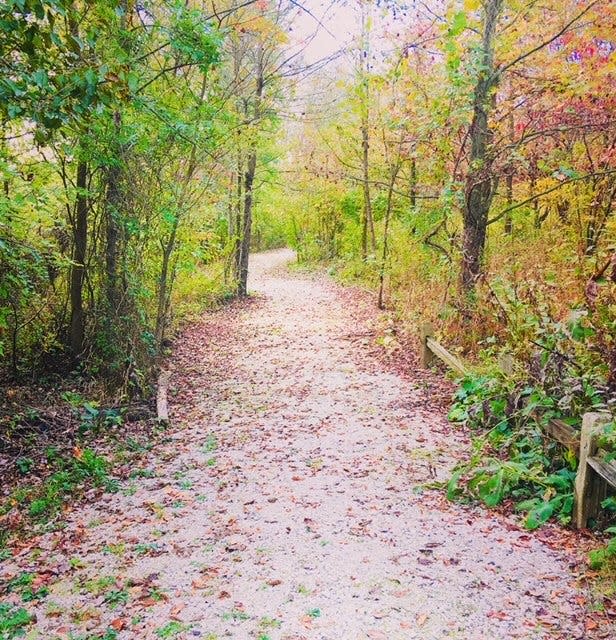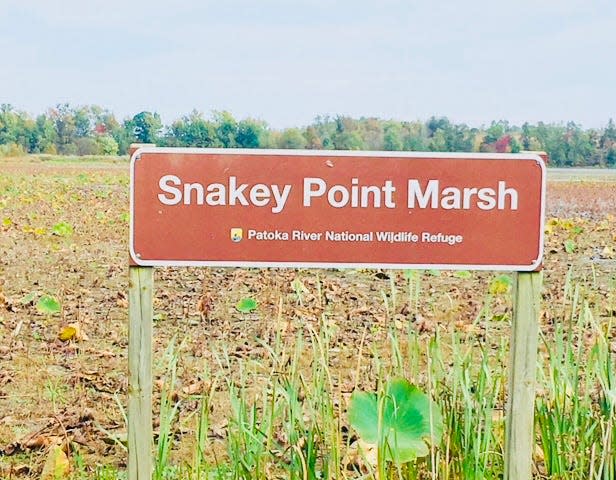A hiker's path: A day on the marshes at Patoka River Wildlife Refuge

The Patoka River National Wildlife Refuge was established in 1994 by the authority of the Emergency Wetlands Resource Act. It is a collection of wildlife refuges and habitats situated along the Patoka River in Gibson and Pike counties in southwestern Indiana.
The wildlife area consists of 23,962 acres. The property follows about a third of the length of the Patoka River which makes it an important refuge.
It is a vast, beautiful place and contains a diversity of habitats. This river bottoms refuge is strategically located to provide important resting, feeding, and nesting habitat for migratory waterfowl, shorebirds, and songbirds. I had also read that the American bald eagle makes its home in the refuge and spends its winters there.
It is one of the few bottomland, forested wetlands in the midwestern United States. This makes it very special and unique.
It was a gorgeous, early fall day when I visited this refuge. I was hoping to hike a couple of trails that were said to be the best wildlife viewing in this wild and wonderful place. I decided on two smaller trails that provided easy access.
The Boyd’s Tree Trail was the first one I decided to explore.
The trail led to a nature identification trail, the fishing pier, and an open view of Snakey Point Marsh.
This marsh was rather large. I only had to walk a small distance to come to the edge of its 247 acres.
There, I found a fishing pier, which looked more like a boardwalk. The pier was made of some type of now faded wood and the weathered planks and the late fall vegetation found growing throughout gave the marsh the look of some ancient sea.

It was very quiet though I could see a few birds floating on the water’s surface in the distance. The water level was lower than I remembered it, probably due to the recent lack of rain in Indiana.
Some of the aquatic plants found in this marsh are spatterdock, buttonbush, American lotus, cattail, creeping water primrose, and marsh pennywort. This late in the year, there were just remnants of the former glory of the these plants which had covered much of the marsh's surface during warmer months.
I truly enjoyed my time on the pier. It was so peaceful.
I finally got back to the trail and continued my hike on the nature trail. It was a self guided loop trail that led back to the parking lot. Along the trail, I discovered small numbered signs in front of different trees and plants growing in the refuge. A small map I had picked up at the trailhead described each tree and plant in detail.
It was very educational.
When I got back to the parking lot, I crossed the road to the trailhead of another marshy area. The Maxey Marsh Nature Trail was my next exploration of the day.
There were more miles to cover and more opportunities to view nature in the raw. My day turned out to be a wonderful adventure.
The refuge has about 10 miles of trails and many are interconnected and can be combined.
There's so much more I could write about this place such as the animals found in the refuge, or the many species of birds found there.
Columbia Mine Preserve, Sycamore Land Trust’s largest property, is a keystone piece in the Patoka River Wildlife Refuge. I also explored this area while I was down there. Look for this story in next week’s column!
To get to this place: From I-69, take exit 33 and head east on Ind. 64 towards Oakland City. Pass through the town and turn left on County Road 1275 East. You will start seeing the refuge and signs to get you there. Make sure to bring drinks and a lunch or snacks! Enjoy your day!
A quote for your week: “Nature is not a place to visit. It is home.” — Gary Snyder, American poet, essayist, environmental activist
Until the next trail,Susan
This article originally appeared on The Herald-Times: Hiking in Snakey Point Marsh and Maxey Marsh Nature Trail
